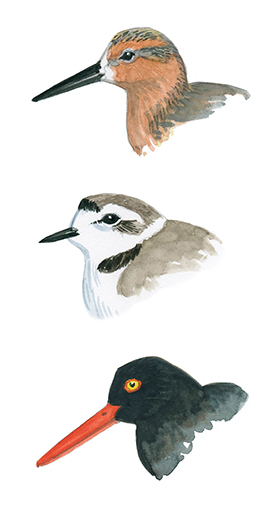
Audubon Adventures

Activities
 Activity 3
Activity 3
Shorebird vs. Local Inland Bird Comparison

 Teacher-led Classroom/Field Activity
Teacher-led Classroom/Field Activity
Science/Research Skills/Geography
How are different birds adapted to different habitats?

Objective
Students compare the adaptations and habitat of a shorebird bird to an inland (non-coastal) bird that lives in their area.
Students will need:
- Shorebird to Local Inland Bird Comparison worksheet (one for each student)
- Bird resources (bird field guides, nature books, Audubon’s online bird guide and other reliable websites, etc.)
- Paper and pencils
Suggested time:
One class period
What to do:
- With their issues of the Sharing Our Shores student magazine in hand (or open on the Audubon Adventures website), have students review the birds featured there, including their physical and behavioral characteristics, where they nest, and what they eat. Make a list on the board or chart paper of the shorebirds featured or pictured in the magazine: Piping Plover, Black Oystercatcher, Snowy Plover, Red Knot, and Killdeer. Invite students to identify ways in which these shorebirds are similar, emphasizing how they are adapted to their watery habitat and the foods they eat.
- Distribute copies of the “Shorebird/Inland Local Bird Comparison” worksheet. As a class, read through the questions in the center column. Elicit examples of answers to questions from students to check for understanding. Spend some time explaining the terms on the range maps: Summer (breeding), Winter (not breeding), Year round, and Migration. (Consider showing an example of a color-coded range map from a field guide or online.) Explain that students can create their own map key using either colored pens/pencils or by shading/dotting/striping with one color.
- Either assign or allow students to choose one of the shorebird species from the list. Have them write the name of the bird on the worksheet under My Shorebird. Then assign or have students choose a local inland bird. (See "Helping Students Select Local Birds for Research," below.) Instruct them to write the name under My Local Inland Bird on the worksheet.
- Give students time with field guides and other resource materials to fill out their data charts. Note that the Sharing Our Shores magazine is one source of information for the shorebirds.
- After the worksheets are completed and questions answered, have students discuss their findings. Challenge students to draw general conclusions about the differences between shorebirds and inland birds. Which group is more migratory? Which is more specialized?
Extension: Invite students to write stories of how each of his or her birds spends an entire year. Where does it go, when, and what does it do there?
Helping Students Select Local Inland Birds for Research
- To avoid confusion with the local inland bird criteria, simply avoid all birds classified as “waterbirds:” the birds featured in the student magazine as well as gulls, terns, pelicans, herons, egrets, skimmers, and so on. Stick to songbirds, raptors (hawks, eagles, falcons), doves, owls, ground birds (quail, doves), woodpeckers, swifts, hummingbirds, swallows, etc.
- If you or a student is unsure if the bird is local, check with a bird field guide. Many state and county wildlife agencies also keep lists of local birds.
- Younger students might do better choosing from a list you’ve made or pulling slips of paper out of a hat with bird names on them. This can also save time.
Photo: Peggy Cook. Illustrations: Sherrie York.




